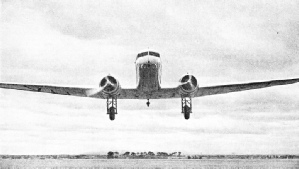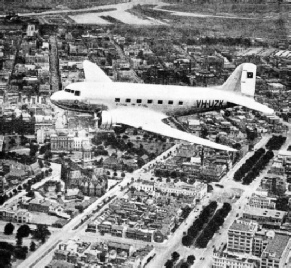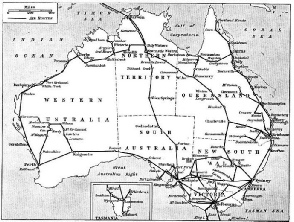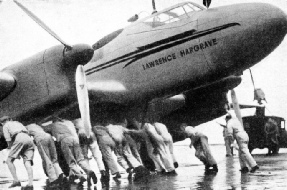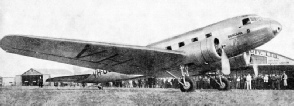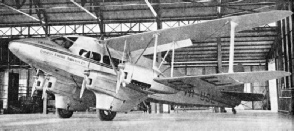

© Wonders of World Aviation 2015-
Australia’s Civil Aviation
Communications of a continent revolutionized by 26,000 miles of airways
AIR ROUTES OF THE WORLD - 3
ONE OF THE LINERS USED ON THE MELBOURNE-TASMANIA route of Australian National Airways. It is the Loongana, a Douglas DC-2 machine. There are two routes from Melbourne to Tasmania, one going direct to Launceston, and the other going to Launceston via King Island and other places. The service also links Launceston with Hobart, capital of Tasmania, and with Flinders Island.
THE aeroplane is playing an important part in the development of vast areas of Australia previously hampered by lack of transport and thus not accessible for intensive settlement. Australian civil aviation has progressed on unusual lines; for in most countries the first air services linked the centres of population, whereas Australia’s first aviation companies began in remote regions where no other form of swift transport existed.
Aircraft are radically altering Australia’s internal and external communications. Formerly the peculiar difficulties of railway, road and sea transport left a vast gap in communications along the long length of the coastline of the northern part of the continent from Western Australia to Queensland. Land and sea communication between State and State and with other parts of the world followed the southern coastal route from Fremantle, the port of Perth, (Western Australia) to Brisbane (Queensland) by way of Adelaide, Melbourne and Sydney. Shipping services linked the island of Tasmania with the mainland. Canberra, the seat of the Commonwealth Government, in Federal Territory, is not of commercial importance. The great gap in communications on the northern coast route has been filled in by aircraft services. Previously Fremantle was the first port for inward-bound mail and the last port for mail outward-bound from Australia. Now the focal port for letter mail is Darwin - once an unfrequented settlement - which is becoming the air mail port for the whole of Australia. Urgent mail to be carried to Europe by ships, via Fremantle, is not now sent by rail, but is flown.
This acceleration of communications between the great cities did not begin, however, until the pioneers of Australian civil aviation had proved the value of aircraft in remote regions.
Australian aviators have achieved world fame in all branches of flying. Among the pioneers of Australian aviation was Lawrence Hargrave (1850-1915), who invented the box-kite and who carried out research into every aspect of heavier-than-air flight, reading papers on this subject before the Royal Society of New South Wales in Sydney. As early as 1912 a central flying school was established, and the formation of a military instructional staff took place in the following year. February 1915 saw the birth of the Australian Flying Corps and at the end of the war of 1914-18 many pilots who had served with this, or with the Royal Flying Corps, returned to civil life in Australia and there gave exhibitions of flying and “joyrides”, thus preparing the way for civil aviation.
Late in 1919 Ross Smith and his brother Keith Smith, with Sergeants W. H. Shiers and J. M. Bennett, won the Australian Government prize of £10,000 for the first flight by Australians from England to Australia. This achievement was followed in 1920 by that of two Australians, Lieut. R. J. Parer, pilot, and Lieut. J. C. McIntosh, navigator. They flew from England in a war-time D.H.9 two-seater biplane and overcame difficulties that would have stopped all except the most resolute men. Sir Charles Kingsford Smith and his colleague Lieut. C. T. P. Ulm, Harry Hawker and “Bert” (Herbert John Louis) Hinkler, are other Australian aviators whose names are engraved on the roll of imperishable fame. The first Australian air mail service was inaugurated in 1921, when Major Norman Brearley, D.S.O., M.C., late of the Australian Flying Corps, formed a company called West Australian Airways, and secured the contract for flying mail over an exacting route between two towns in Western Australia. One town, Geraldton, on the west coast, was linked by railway with Perth. The other town, Derby, at the head of King Sound, in the Kimberley district, and more than 1,000 miles away, was out off from civilization. The company began operations with Bristol tourers, which were reconstructed war machines. Each was powered by a 240 horse-power Armstrong Siddeley Puma engine, and carried the pilot and two passengers.
In 1920 two war-time pilots of the Australian Flying Corps, Hudson Fysh and P. J. McGinnis, conferred in a Brisbane hotel with two Western Queensland sheep farmers. This conference was the beginning of the Queensland and Northern Territory Air Service, which was promptly abbreviated to Qantas - now Qantas Empire Airways and the Australian end of the Empire air route between Singapore and Australia. Three railways began at ports on the coast and ran westwards into Queensland, but the inland termini were not linked up. In fine weather wheeled transport linked these ends. In wet weather the transport could not operate: roads were flooded and the unbridged streams, fordable in the dry season, became raging torrents.
Rescues from Floods
The pioneers determined to link the railways by air. In November 1922 they began a service from Charleville, inland on the railway from Brisbane, to Longreach, inland on the railway from Rockhampton, and on to Cloncurry, inland on the railway from Townsville. Longreach was the headquarters where machines were kept in repair; aircraft were built there later. The original route linking the railways was operated with three Armstrong Whitworth two-passenger machines and one D.H.4, all war-time aeroplanes.
Such were the demands on the service that these were replaced, first by D.H.9C three-passenger machines and then by D.H.50s, seating four passengers. The original line of 577 miles was extended from Cloncurry to Camooweal, on the border of Queensland and the Northern Territory, a distance of 248 miles. The next stage was from Cloncurry to Normanton, at the south-east corner of the Gulf of Carpentaria, a distance of 215 miles. Then, as the railway connexion between Charleville, the southern air base, and Brisbane, was slow, an air service between Charleville and Brisbane, a distance of 450 miles, was begun with seven-passenger D.H.61s. Thus was established an air service from Brisbane to the Gulf of Carpentaria, affording rapid transport in remote areas.
In addition to carrying passengers and mail, the machines added greatly to the amenities of life. Fresh butter, vegetables and food from the pastoral country inland were carried to the Gulf settlements, and freshly caught fish was flown as return freight to the inland centres. When, during the “wet”, as the rainy season is called, homesteads were marooned by floods, aeroplanes came to the rescue with food. When a big sheep station was cut off, sheep-shearers were flown to it so that shearing could begin without the delay that would have been caused had the shearers waited for wheeled transport to resume operations. Stock-buyers in search of animals, police hunting for criminals, serums to combat disease, documents, urgently wanted medicines, parts of machines and a great variety of freight were carried. Such was the beginning of air transport in Queensland.
THE KURANA IN FLIGHT OVER MELBOURNE. This liner is a Douglas DC-3 used by Australian National Airways on the Melbourne-Tasmania service. The Kurana is air-conditioned, the air being changed every two minutes. Moreover, each passenger can control the air in his immediate vicinity by turning a valve. The two radial engines develop a maximum horsepower of 1,000 each. The timetable allows one hour fifty minutes for this aeroplane to fly the 314 miles from Melbourne to Launceston.
An extensive newspaper delivery on Sundays from Brisbane began in a small way about the year 1926. Captain Harold Fraser, of Rockhampton Aerial Services, used to fly to Brisbane every week-end and return on Sunday with a few papers. Many people began to ask him to bring back papers for them. Later, a Brisbane Sunday newspaper, in cooperation with Rockhampton Aerial Services and Air Lines of Australia, organized special newspaper deliveries by air from Archerfield Aerodrome, Brisbane. This has been claimed to be the greatest newspaper aerial delivery network in Australia, and probably, for distance, in the world. Once a week the aeroplanes take off in the early morning and fly to Maryborough, Bundaberg, Gladstone, Rockhampton, Mount Morgan, Mackay, Ayr and Townsville. Road motor services based on the aerodromes distribute the newspapers to the surrounding districts.
A service which links Charleville, Queensland, with Cootamundra, an air junction in New South Wales, is operated by the Butler Air Transport Company. C. A. Butler, of this company, flew from Lympne, England, to Darwin, in the then record time of 9 days 1¾ hours, arriving on November 9, 1931, in a Comper Swift monoplane. The joint managing directors of the company which linked Brisbane, Sydney and Melbourne by air were Sir Charles Kingsford Smith and Lieut. Ulm. Passing as it does over the mountains, the Sydney-Melbourne route is not an easy one. Cloud and mist are prevalent in winter, and dust storms, sometimes so thick that visibility is reduced as though by fog, are encountered in summer.
From Melbourne services operate to Adelaide, and across Bass Strait to Tasmania. One air route goes northward across the heart of Australia to Darwin and another westward to Perth. Before progress was made with the beginning of the all-air route to Europe via Darwin, the establishment of the air mail route between Adelaide and Perth was of particular importance, as the rail transport between the two cities was not fast.
MAP SHOWING ALL THE IMPORTANT AIR ROUTES OF AUSTRALIA. They are operated by a number of companies, some of which are subsidized. All manner of freight is carried, including perishable food. The advent of these airways has proved a boon to people living in remote parts to which surface communications are difficult and which may be completely cut off for long periods during the rainy season. The first Australian air mail service was established in 1921 on the west coast of Australia between Geraldton and Derby.
The Perth-Adelaide air mail began in June 1929, and was originally operated by West Australian Airways. In recent years numerous Australian air companies have amalgamated and this section is now part of the extensive system of Australian National Airways. This route is 1,453 miles long. At one time the machines left Perth. in the morning, landed passengers for luncheon at Kalgoorlie, and flew them in the afternoon to Forrest, where they stayed overnight in a rest-house. They left in the morning for Ceduna, and after a meal completed the journey to Adelaide, which was reached soon after noon. These schedules were accelerated with the introduction of Douglas DC-2 Transport machines powered by two Wright Cyclone 760 horse-power engines. The schedule at the time of writing provides services from Perth to Adelaide on Mondays, Wednesdays and Fridays. Machines leave at 6.45 a.m, arrive at Kalgoorlie at 8.50 a.m. (345 miles), from where, twenty minutes later, they fly to Ceduna, arriving at 2.55 p.m. (1,098 miles). At 3.15 p.m. they take off for Adelaide (1,453 miles), which is reached at 5.15 p.m. The service in the reverse direction is on Sundays, Tuesdays and Thursdays. Machines leave Adelaide at 7.30 a.m. and, after stops at Ceduna and Kalgoorlie, reach Perth at 4.15 a.m.
The significance of this part of the Australian trunk air routes is that it has taken about two days off the railway time. The air route follows the track of the Trans-Australian Railway for most of the way, but the average speed of expresses is less than 30 miles an hour. Even in the early days of the air mail when an overnight stop was made at Forrest the advantages of air travel were great, because of the higher speed. Travellers by air found that they avoided the heat and dust of land transport.
The single fare is £15 15s. (Australian), and this includes meals and transport between terminal cities and aerodromes. Maylands, the airport of Perth, is four and a half miles from the city, and Parafield Aerodrome is nine miles from Adelaide. The service carries passengers, mail and goods and is subsidized.
From Adelaide the distance by air direct to Melbourne is 404 miles, that from Melbourne to Sydney is 440 miles, and that from Sydney to Brisbane 475 miles. A daily service (Sundays excepted) between Adelaide and Sydney is operated by Guinea Airways, fares being £10 10s. single and £19 return. The route from Adelaide is Mildura, Victoria, 205 miles; Hay, N.S.W, 365 miles; Leeton, 460 miles; Cootamundra, 555 miles; Sydney, 775 miles. One service leaves Adelaide at 8 a.m. and arrives at Sydney at 2.30 p.m.
Across Bass Strait to Tasmania
The service in the opposite direction leaves Sydney (Kingsford Smith Airport) at 11.45 a.m. and reaches Adelaide at 5.5 p.m. Air liners of this company include: Lockheed Electra 10A, powered by two Pratt and Whitney Wasp Junior 400 horse-power engines; Taifun BF 108B, powered by a 200 horse-power Argus AS 10C engine, this machine accommodating four persons including the pilot.
Australian National Airways and Airlines of Australia operate services between Adelaide and Melbourne with Douglas DC-2 liners and D.H.89s, the latter being powered by two Gipsy Six engines, each of 180 horse-power. One direct service of 404 miles from
Melbourne is scheduled for two hours ten minutes for the Douglases. Another route via Mount Gambier and Naracoorte, with stops at each place, brings the distance to 474 miles, and the total time to more than four hours.
Various short but important services radiate from Adelaide to important centres. Melbourne has its airport at Essenden, seven miles distant from the heart of Melbourne. The airport is the hub of services which form nine spokes radiating outwards. Two of these services cross Bass Strait and join at Launceston, Tasmania, from which there are various connecting services.
A JUNKERS AIR LINER IN AUSTRALIA, named Lawrence Hargrave, after one of the pioneers of Australian aviation. Hargrave was the inventor of the box-kite and carried out early research into every aspect of heavier-than-air flight. He died in 1915. The aeroplane in this picture was imported into Australia under a barter agreement by a Sydney wool-broker. It has Diesel engines and was the first of its kind to enter Australia.
The service between Melbourne and Tasmania is operated by Australian National Airways. Among the aircraft on this service is the Kurana, a 21-seater Douglas DC-3, powered by two radial engines, each developing 1,000 horse-power at the take-off and from 500 to 650 horse-power at cruising speed. The liner is air-conditioned, and the air is changed every two minutes. Each passenger can control the supply of air to his immediate vicinity. Deep leather armchairs with adjustable seats and backs, ash-trays, individual reading lamps and a colour scheme in green and buff, with orange curtains, are other features of this excellent American machine.
The present timetable from Melbourne by this fast aeroplane allows one hour fifty minutes for the 314 miles to Launceston. After a stop of ten minutes the aeroplane flies the 94 miles to Hobart in forty-five minutes. Other aircraft on this route are the Loongana and Bungana, both Douglas DC-2s. Some of the machines from Melbourne fly to King Island in Bass Strait, then to Wynyard, in Tasmania, also calling at Smithton if required, and then fly to Launceston. From Launceston there are services to Hobart and also to Flinders Island, on the east side of Bass Strait, King Island being on the west side. Single fare from Melbourne to Hobart is £6 5s. and from Melbourne to Launceston, £4 10s.
The direct Melbourne-Sydney route of 440 miles is scheduled as follows: Melbourne noon, Sydney 2.45 p.m; Sydney 10.15 a.m, Melbourne 1.5 p.m. Other services proceed via Wagga and Canberra, but this increases the distance to 490 miles and brings the total time to more than four hours. These routes are operated by Australian National Airways and Airlines of Australia with various types of liners, including Douglases and 14-seater D.H.86 machines with four Gipsy Six engines,each developing 180 horse-power.
Another service between the two biggest cities in Australia is operated by Ansett Airways, via Narrandera (a little south of Leeton); the route is 500 miles long. Machines include Lockheed Electra 10B, with two Wright Whirlwind engines, each developing 420 horse-power. The machines have eighteen seats. Single fare is £6 by this route. The Sydney Brisbane services of Airlines of Australia are operated by Douglas DC-3 and Stinson Model A liners, the Stinsons having three Lycoming 235 horse-power engines. The direct route of 455 to 475 miles is flown in about three hours. The route involving calls at Grafton and Lismore brings the mileage to 500 and increases the time by half an hour. Single fare is £7.
The beginning of the year 1938 was marked by efforts to accelerate the services between the big cities by adding faster air liners, improving aerodromes and improving the ground organization.
Through the Northern Territory
The MacRobertson-Miller Aviation Company , of Perth, maintains services from Perth along the west and northwest coast to Derby, beyond which the route turns inland to Ord River; here one route goes to Wyndham, at the head of Cambridge Gulf, and another to Daly Waters, where it meets the Brisbane-Darwin route of Qantas Empire Airways and also the Guinea Airways Adelaide-Darwin route. The distance from Perth to Daly Waters is 2,252 miles.
The aircraft used on this long route include D.H.84s with two Gipsy Major engines. Single fare from Perth is £25 and the passenger has to pay for hotel accommodation when the aeroplane stops for the night. Machines leave either terminal twice a week. On Sundays an aeroplane leaves Perth at 10 a.m. and flies to Geraldton, 255 miles, and then to Carnarvon, 355 miles, which it reaches at 3.55. The passenger stops the night and joins the aeroplane at 6 a.m. on the Monday. It flies via Onslow, 773 miles; Roebourne, 921 miles; Whim Creek, 964 miles; and Port Hedland, 1,028 miles, to Broome, 1,345 miles, reached at 3.45 p.m. On the Tuesday the machine takes off at 5.30 a.m. for Derby, 1,445 miles, then it leaves the coast for Noonkanbah, 1,564 miles; Fitzroy, 1,618 miles; Hall’s Creek, 1,775 miles; Ord River, 1,877 miles; Wave Hill, 2,016 miles; and reaches Victoria, 2,088 miles, at 4.55 p.m. for the stop overnight. On the Wednesday at 6.20 a.m. the machine leaves for the final stage to Daly Waters, 2,252 miles, where it is due at 8 a.m. If the traveller proceeds via Darwin and Singapore to London the total length of the journey by air will be 13,306 miles.
The spur route. from Ord River proceeds to Argyle, 78 miles; Ivanhoe, 118 miles, and on to Wyndham, 154 miles. A D.H.83 leaves Ord River at 1.30 on Sunday afternoons and arrives at Wyndham at 4 p.m., the service being a weekly one. The service in the reverse direction is on Saturday mornings.
Another long route across sparsely inhabited regions is the Guinea Airways weekly service from Adelaide to Darwin. The machine leaves Adelaide at 7 a.m. on the Saturday and flies via Farina, 325 miles; Oodnadatta, 583 miles; and Alice Springs, 868 miles. Tennant Creek, 1,163 miles, is reached at 4.30 for the overnight stop. At 6.30 on the Sunday morning the aeroplane leaves for Daly Waters, 1,402 miles; and Katherine, 1,559 miles; it reaches Darwin, 1,730 miles, at 10.50 a.m. Single fare, which includes meals and hotel accommodation, is £30.
ANOTHER OF THE AIRCRAFT ON THE TASMANIAN SERVICE, the Bungana. This is a Douglas DC-2 liner. The letters VH are the international marking for Australian aircraft, in the same way as G is the marking for Great Britain. All countries which are parties to the “Convention relating to the Regulation of Aerial Navigation” have letters of identification allotted to them.
A service which forms two sides of a triangle, the base of which is the Perth-Kalgoorlie section of the Trans-Continental air route, is the Perth-Wiluna-Kalgoorlie route operated by Airlines (W.A.). This proceeds from Perth to Dalwallinu, 120 miles; Mount Magnet, 290 miles; Cue, 350 miles; Reedy, 388 miles (or Nannine, 380 miles), to Meekatharra, 430 miles. Here the aeroplane turns eastward to Wiluna, 538 miles, where the overnight stop is made. Leaving Wiluna in the morning, the machine turns south for Mount Sir Samuel, 613 miles; Lawlers, 644 miles; Leonora, 719 miles; and on to Kalgoorlie, 820 miles. Calls are made at other places when required.
The western section of Australia's air routes has produced remarkable changes in the lives of the men who have settled in distant places. Some settlements were out of touch with supplies for months at a time.
Originally the intention was mainly to carry mail, but the benefits have extended far beyond the hopes of the pioneers of 1921. Thanks to radio and to the steady improvement in the air services the standard of life has been raised. Medicines, replacements of parts of machinery, urgently needed stores and supplies of all kinds can be ordered by radio from cities such as Perth and delivered within a few days to places a thousand miles away.
Clothes, newspapers, repairs to spectacles, dentures, films, plants and flowers, fruit and fish are flown to homesteads which otherwise would have to exist in the primitive conditions that used to be taken as an unavoidable part of a pioneering life. Some of the freight is queer cargo. Trout-eggs have been flown from Melbourne to Perth. Mercury for a mining engineer was a compact but weighty parcel. Prize eggs are flown to farmers for their incubators; some prefer chicks. Other freight has included part of a windmill, a wedding cake for an “outback” wedding, a prize pig, nightingales, finches, parrots, and black or white cockatoos. Dahlias growing near the Indian Ocean have been packed in moist earth, flown across the continent to Sydney and planted in a garden caressed by the breezes from the Pacific.
In districts made habitable for man and his beasts by pumping water from below the surface of the earth, the aeroplane enables the engineer to make the rounds of the plant under his charge. If a defect develops in the machinery and the flow of precious water ceases, the engineer flies to the station with his gear and makes good the defect. So vast is the country that the cost of building roads or railways and maintaining them is prohibitive. There are virtually no navigable rivers. The aeroplane is the only swift means of travel.
Route 2,028 Miles Long
Although these airways into the bush lack the highly scientific ground equipment of the great trunk lines of the United States and Europe, the skill of the pilots is not surpassed anywhere in the world. In 1932 two German aviators, Hans Bertram and Adolph Klausemann, landed in a Junkers seaplane near Rocky Island in the Kimberley district on the north coast of Western Australia. The air mail pilots made flight after flight and combed 3,000 miles of country and coast till they found the aircraft and the two men in a cove, since named Seaplane Bay. Air-taxi work is another branch in which Australians excel. Prospectors, geologists, pastoral experts, Government officials, surveyors and scientists are flown to the heart of the continent.
A number of expeditions in quest of gold have relied upon aircraft. Every pilot who undertakes the task of flying into the wilderness has one great confidence - if anything happens to him and his machine, Australian pilots will search until they find him.
The Qantas route from Brisbane to Darwin is 2,028 miles long. D.H.86s powered by four Gipsy Six engines, each of 180 horse-power, leave on Wednesdays and Saturdays at 7 a.m. The first stop is at Roma, 280 miles; the next stages are Charleville, 438 miles; Blackall, 606 miles; Longreach,705 miles; Winton, 812 miles; Cloncurry, 1,011 miles. Here passengers stop for the night. The second day’s flight is via Mount Isa, 1,112 miles; Camooweal, 1,226 miles; Brunette Downs, 1,416 miles; Newcastle Waters, 1,621 miles; and so to Darwin, 2,028 miles, which is reached at 3.5 p.m. This route is part of the Empire Air Route to England, Hong Kong and South Africa.
Services operated by North Queensland Airways link Cairns, on the Pacific Coast, with Burketown, on the Gulf of Carpentaria, via Normanton, a distance of 450 miles. Another route operated from Cairns by the same company goes north to Cooktown, 100 miles up the coast, and this connects with a less frequent service to Portland Roads, 380 miles from Cairns on the Coral Sea coast of Cape York Peninsula.
The total route mileage of the companies operating in Australia by 1938 was 26,500. Subsidized services comprised 11,866 miles, and unsubsidized services 14,634 miles.
DE HAVILLAND EXPRESS AIR LINER of Qantas Empire Airways. It is powered by four Gipsy Six engines. These engines are of the inverted type, the crankcase being above the cylinders. Qantas Empire Airways had its beginning in 1920 in the Queensland and Northern Territory Air Service. It is the company which operates the Australian end of the Empire air route between Singapore and Australia.
You can read more on
“Across the Pacific”
and
“Air Mails of the Empire”
and
“Flying in New Zealand”
on this website.
